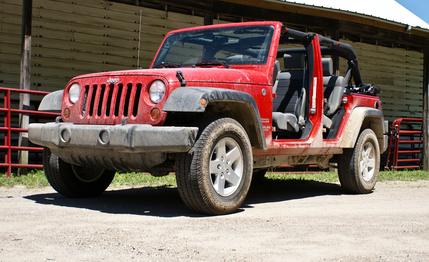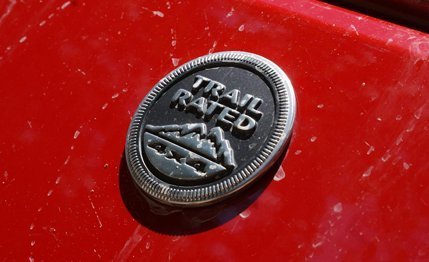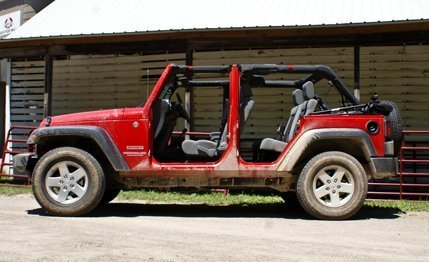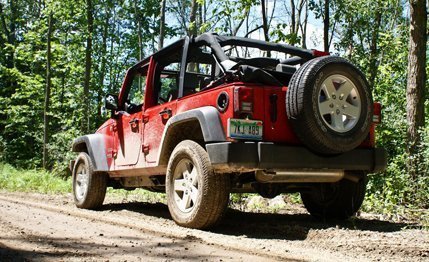 Quick Spin
Quick Spin
Introduced in 2006 as a 2007 model, the Wrangler Unlimited is the four-door version of Jeep’s iconic off-roader and, technically, the only four-door convertible on sale today. It’s nearly 21 inches longer than the two-door version, permitting five seats instead of four, along with some additional cargo space. The only engine is a 3.8-liter V-6 that produces 202 hp and 237 lb-ft of torque. Rear-wheel-drive Unlimiteds are available only with a four-speed automatic transmission; the auto is an $825 option on 4x4 examples, which come standard with a six-speed manual. A folding softtop is standard, and a removable hardtop is optional. There are few changes for 2010. Fog lights, tow hooks, and a digital compass and ambient-temperature readout are now standard on four-door Wranglers.

Unsurprisingly, the Wrangler Unlimited is slooow, especially at highway speeds, where its blocklike aerodynamics comes even more into play. The steering is lifeless, and there’s an overdose of wind noise even with the roof and windows in place. And once the novelty of driving a manual-transmission Wrangler—like our test vehicle—wears off, you notice that it takes a decent amount of effort to slot the shifter into each gear. This Jeep’s not a green choice, either—we managed just 16 mpg.
On the other hand, the Wrangler’s back-to-basics driving experience is a refreshing departure from that of pretty much any other modern vehicle. Without abundant electronic aids and gizmos, you can actually enjoy the simple task of driving; in this respect, the Wrangler reminds us of the Mazda Miata, even if that’s where the similarities essentially end. One cool feature: With the transfer case locked in low range, you can start the engine in first gear without depressing the clutch. It’s designed for off-roading and can help avoid clutch wear and keep you from sliding backward if you stall while crawling over a particularly nasty obstacle.

After coming to terms with the Wrangler, we like that it feels so unrefined and that you can feel and hear the mechanical bits clunking and whirring. The Wrangler works well as a big, burly convertible. Removing the side windows and soft top is fiddly work for newcomers, but using the zippers and the Velcro soon becomes second nature. You can detach the doors by undoing two Torx screws per door. What other new car can be disassembled so easily?
Determining how the Wrangler stacks up is a tall task, because there’s nothing else like it. In on-road performance and comfort, the Wrangler is less modern, slower, and less fuel efficient than almost anything else out there. Based on price alone, people might be tempted to compare the Wrangler with crossovers like the Toyota RAV4 or Volkswagen Tiguan, but those are different animals entirely—especially the Tiguan, which isn’t even a real animal. Of course, all such crossovers lack the Jeep’s off-road chops.
Although it can feel downright primitive at times, the Wrangler trumps pretty much any other vehicle in its intangible coolness. We can think of no other transport in America capable of tackling the most treacherous terrain on earth and serving as a five-seat droptop cruiser for trips to the Dairy Queen. It’s this charisma that makes any on-road flaws somewhat irrelevant. The Wrangler isn’t most folks’ idea of a commuter car, but its all-around versatility and fun personality make it an appealing choice for anyone trying to avoid a dull economobile. Even with thousands of them on the road, the Wrangler still feels like an iconoclast’s choice, and you know immediately if it’s your kind of ride as soon as you slide behind the wheel. (Check out our own P.J. O’Rourke’s love letter to the Jeep if you still don’t get it.)

The Wrangler Unlimited is offered in three trims: entry-level Sport, midrange Sahara, and you-can-crush-mountains Rubicon. Our Unlimited Sport 4x4 started at $25,355 and came with 16-inch wheels, air conditioning, a six-speaker audio system with an auxiliary input, stability control, and ABS as standard. The only option on our Wrangler was the $2290 Power Convenience package, which nets 17-inch wheels, cruise control, a leather-wrapped steering wheel, power windows and locks, keyless entry, and an alarm. If you go for the half-metal, half-fabric doors as on our test example, you save $500 from the package price but give up the power windows and locks, keyless entry, and alarm. With the half-doors, our Wrangler totaled $27,125.
As a compromise to keep the lost equipment, you could buy the half-doors as accessories from Mopar and then have the choice of using those or the full doors. It doesn’t work the other way around, however; if you want full metal doors, you’d better get them from the factory, as they can’t be purchased later. But be forewarned that the accessory half-doors cost $2300, come unpainted, and require some assembly and the installation of lock cylinders before use, which strikes us as a lot of money and effort. (And that’s before you purchase the interior door panels and vinyl windows.) Then again, what price freedom?